
Poa? :-)
I am a polo shirt guy and it took me some time to get this embroided on a black and a blue polo shirt. But if you’re more into T-Shirts and live in the US, this shop may be what you’re looking for.
Really.
I was a need of a new sheath for my cards & papers as the old one was a bit worn out after a few years with daily use:
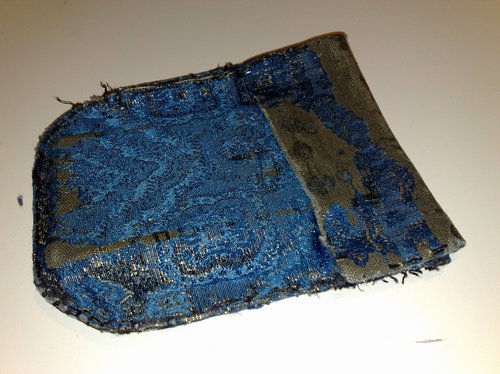
Green canvas is from Kenya, btw.
So I bought this leather wallet today for EUR 25,-
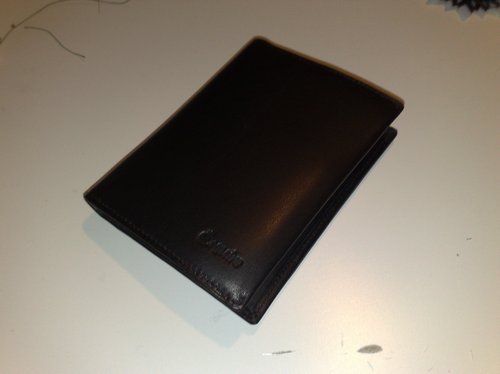
…which doesn’t work for me. One of the reasons I’d come up with my own sheath/wallet is that I only put my cards & papers in there and keep the money somewhere else. So it has to be as slim as possible – which isn’t the case with the new sheath.
After trying the new leather sheath for a minute, I quickly decided to make a new one, similar to the old one. Never change a running system.

Costs: 0,- EUR
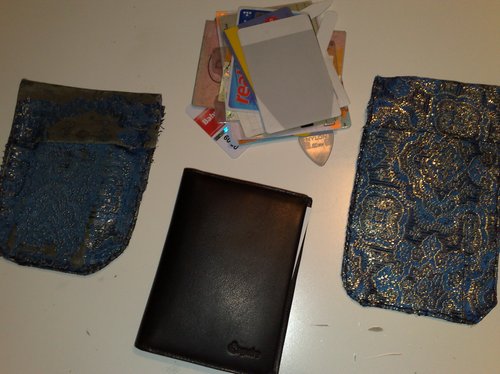
old, new & soon-to-be-returned, new + the pile of cards that have to fit in there.
One of the reasons for using this special material is that it actually looks so strange that no one will really want to steal it.
Ein Artikel online über Demenz brachte mich auf Umwegen zu Tilman Jens, der ein sehr streitbares Buch über …. den Umgang mit seinem Vater, Walter Jens , geschrieben hat.
Überhaupt, dass ein 54jähriger Mann immer wieder als “Sohn von…” eingeleitet wird, wäre dann schon Grund genug, sich noch zu Lebzeiten zu differenzieren. Aber so?
Das Thema Alzheimer haben wir in der eigenen Familie von Anfang bis Ende durchlebt und nachdem der Spuk jetzt endlich vorbei ist, frage ich mich immer wieder: was bleibt?
Was bleibt – außer der Erinnerung, der Liebe, den Verbindungen – vom Intellekt, vom Schaffen zurück?
Menschen sind wie Bäume. Je älter sie werden, desto mehr Jahresringe bekommen sie und können besser verwertet werden. Spenden sie zu Lebzeiten Schatten und Schutz, können aus ihren Stämmen später lange und breite Bretter gesägt werden. Je mehr ein Baum erLebt, desto ergiebiger lässt sich davon profitieren.
Leider stimmt der Vegleich an dieser Stelle nicht mehr, denn Krankheiten wie Alzheimer oder Parkinson befallen Menschen wie ein Pilz, der die Substanz verändert und genau dort ansetzt, wo es am meisten schmerzt. Aus brauchbar wird unbrauchbar.
Eine ähnliche Frage stelle ich mir immer wieder bei Online Publikationen, die oft weniger breit und nachhaltig irgendwo im weiten Datennetz erscheinen und ob der Fülle an Informationen im Datennirwana untergehen.
Dieser Blogpost könnte auch ganz anders betitelt werden und ich könnte vielleicht von Anfang an hervorheben, dass ich mich viel lieber mit der Bedeutung von Onlineveröffentlichungen vs. Büchern beschäftigen würde.
Allein, ich vermag es in seiner Gänze nicht zu erfassen, gar zu überblicken, daher beschränke ich mich auf simple Fragen und stelle im Folgenden drei Bücher vor, die jetzt dank Amazon den Weg auf meinen Schreibtisch gefunden haben und sich elegant an der sonstigen Pflichtlektüre vorbeimogeln.
Die Pflichtlektüre besteht zur Zeit übrigens aus wissenschaftlichen Publikationen zum Thema Abwasserbehandlung in Entwicklungsländern, was zwar technisch überaus interessant ist, aber eben nicht faszinieren vermag – ganz im Gegensatz zu Gegenwartsliteratur über den afrikanischen Kontinent.
Eines aber noch vorweg: wenn wir in Zeiten einer WebCiety den Wechsel hin zu einer sich-ins-Netz-verlagernden-Gesellschaft bemerken, in der die Kommunikation miteinander an erster Stelle steht, stelle ich mir zwangläufig immer wieder die Frage: welchen Stellenwert haben Bücher (gedruckt, auf Papier) im 21. Jahrhundert?
Und: wer soll das alles lesen (?)…. in einer Zeit, in der die Aufmerksamkeitsspanne von Jugendlichen durch MTV und YouTube gerade einmal gefühlte 10 Minuten beträgt und wenn Informationen nicht mehr in kleinen Häppchen oder gar in Linkform präsentiert werden?
Wenn wir weiterhin davon ausgehen, dass sich moderne e-Book Reader (wie Amazons Kindle und kostengünstige Einsteigercomputer wie Netbooks als alternative e-Book reader) durchsetzen werden (oder gar Handyromane, wie in Japan schon sehr populär), wie werden diese Inhalte (und nur darum geht es eigentlich) mit dem neuen Konsumverhalten vernetzt? Werden unsere Kinder das Buch als solches wahrnehmen und konsumieren, oder eher als Teil des Wissens in einer virtuellen Bibliothek abspeichern? Und wie werden sie damit umgehen?
Alles Fragen, die mich immer wieder beschäftigen und die micht jetzt trotzdem nicht vom Kauf der folgenden Exemplare abgehalten haben:

Michaela Wrong: “It’s our turn to eat – the story of a Kenyan whistle blower”
Über John Githongo und seinen Kampf gegen die kenianische Korruption. Aufgeschrieben von Michaela Wrong, die ihn seinerzeit in seinem selbstgewählten Exil in England aufnahm. Michaela Wrongs Buch über Mobutu wurde schon gierig verschlungen und liest sich gut, ähnliches erwarte ich daher auch von diesem Werk, das die (größtenteils schon bekannten) Verstrickungen kenianischer Politiker in Korruptionsskandale beschreibt .
Dieses Buch wird in Kenia zur Zeit wohl nur unterm Ladentisch verkauft und dürfte sich zu einem Beststeller entwickeln, denn – anders als der Verfall Kongos – handelt es sich bei Kenia um eines der reichsten Länder Afrikas. Freilich hat Kenia nicht die Bodenschätze, wie sie Botswana oder der Kongo (DRC) aufweisen können. Seinen Reichtum zieht es vielmehr aus der geopolitisch günstigen Lage am Indischen Ozean (Hafen, Tourismus), den vielen Exilkenianern im Ausland (die für einen informellen Geldfluss sorgen) und vielleicht auch noch aus der Agrarwirtschaft (Kaffee, Tee, Blumen). Und während viele Ministerien immer noch vom Geldsegen der EU abhängen, die gelegentlich ein paar Pickups als Projektautos finanzieren, verfügen viele kenianische Politiker über ein sehr gutes Einkommen, das im sehr krassen Verhältnis zu ihren eigenen Leistungen, aber vor allem dem Durchschnittseinkommen im Lande steht.
Korruption als solche mag für viele als Ausgleichssystem für die vielen Ungerechtigkeiten in der Volkswirtschaft verstanden werden. Tatsächlich jedoch ist sie wie ein Pilz, der ein gesundes System zerstört und unbrauchbar werden lässt.
Die wirkliche Kernaussage dieses Buches scheint aber zu sein, dass das korrupte System vom scheinbar eigenen Mann aufgedeckt worden ist, der als Vertreter einer neuen Generation mit anderen Werten und Idealen aufgewachsen ist. Was wir hier sehen, ist der ungerechte Kampf zwischen den alten Männern eines über die Jahre gewachsenen profitablen Systems und einzelnen Vertretern wie John Githongo, die über einen viel moderneren Erfahrungshorizont verfügen.
Wäre ich ein bißchen Deutscher und älter – vielleicht so wie Tilman Jens – würde ich es vielleicht mit den Identifikationsproblemenen der 1968/1978er Generation im Nachkriegsdeutschland vergleichen. Interessant dabei: die wirklichen Auswirkungen erkennen wir oft erst an der folgenden Generation.

Dominic Johnson “Kongo: Kriege, Korruption und die Kunst des Überlebens”
Dominic Johnson ist mir als Afrika Korrespondent der taz bekannt, dessen Artikel seinerzeit mit einer der Gründe für mein taz-Abo waren.
Ich war noch nie im Kongo, jedoch steht die Region auf meiner Reiseliste ganz weit oben. Aufmerksame Leser meines Blogs wissen sicherlich, dass ich hier schon den einen oder anderen Artikel mit Inhalten zum Kongo (als Region, nicht nur DRC) veröffentlich habe. Kurzum: für mich ein überaus vielversprechendes Buch, in dem ich vielleicht auch meine Vermutung wiederfinden werde, dass sich die “Demokratische Republik Kongo” in den nächsten Jahren in Einzelstaaten aufteilen wird. Der Kongo ist die für mich zur Zeit spannendste Region Afrikas.
“Die Kunst des Überlebens” – ja. Trefflicher kann man es wohl nicht beschreiben.
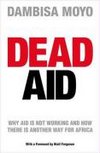
Dambisa Moyo: “Dead Aid – Destroying the biggest global myth of our time”
Ein Buch im Stil von Prof George Ayitteys “Africa Unchained – The Blueprint for Africa’s Future”, das die “Ablasszahlungen” des Westens an Afrika beschreibt und einen neuen Weg aufzeigen möchte, der wirkliche Entwicklung in Afrika ermöglichen soll.
Da ich auch in dieser aufgeklärten Zeit immer wieder auf Zeitgenossen stoße, die ein komplett falsches Bild vom afrikanischen Kontinent und dem riesigen Potential haben, ist es umso wichtiger, Vertreter neuer Theorien zu entdecken, die – wissenschaftlich fundiert – eine eigene Lösung aus der Misere beschreiben und idealerweise auch noch über die nötige berufliche Erfahrung verfügen, die ihre Glaubwürdigkeit untermauert.
In Dead Aid, Dambisa Moyo describes the state of postwar development policy in Africa today and unflinchingly confronts one of the greatest myths of our time: that billions of dollars in aid sent from wealthy countries to developing African nations has helped to reduce poverty and increase growth. (Quelle)
Dambisa wurde letztens auch von der BBC im HardTalk interviewt und ich habe sie vorhin via Twitter auf das Africa Gathering Ende April in London hingewiesen. Mal schauen was draus wird…Sie kann nicht, ist auf Lesereise in den USA.
The silver lining der hier vorgestellten Werke ist für mich ganz klar die Erkenntnis, dass es Veränderungen in Afrika nur durch eine neue Generation geben kann, die – aufgewachsen mit traditionellen Verhaltensmustern und typischen US-amerikanischen SitComs wie dem Fresh Prince of BelAir – ihren eigenen Weg finden muss.
UPDATE: Fünf Wochen nach VÖ dieses Beitrags ist in der FAZ ein Interview zu Dambisa Moyos Buch erschienen. Und jetzt hat sie sogar wohl noch im Vortrag bei der Weltbank überzeugt. Wer sich auch nur ein bißchen mit Afrika beschäftigt, sollte dieses Buch unbedingt lesen – kann es wärmstens empfehlen. Weniger um einen möglichen Lösungsweg aufgezeigt zu bekommen, als vielmehr die moderne Einstellung des neuen Afrikas zu verstehen.
Two and a half days aren’t enough to explore the full potential of a city. That’s why I can only present a few snapshots this time. Besides, I am too tired for a decent post these days.
Have been working on another professional blog for a paid project (no URL, pole) the last couple of weeks and whenever I open my own blog, I think about a relaunch. After all, I am still using the same template since 2006!
I urgently need to get some sleep asap and refocus my agenda on other, much more important matters (like my thesis, for instance).
‘Nways, back to Vienna and some visuals:
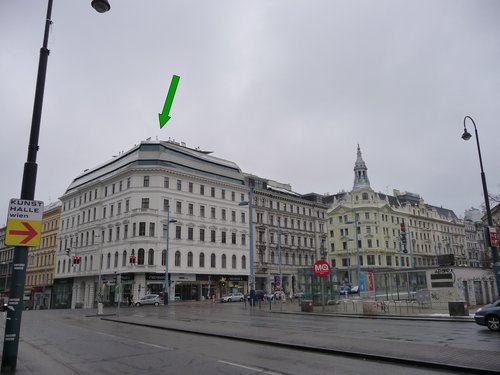
What a roof!

THE best ticket machine I’ve seen in Europe so far. Took us less than 10 seconds to buy a ticket for the metro. See my ramblings on RMV/Frankfurt am Main to understand why this is so important to me.

Lovely street-art next to Hotel Orient.
No, don’t ask. Garen showed us that place…
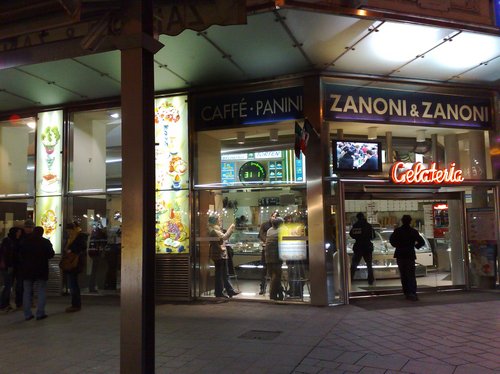
Best ice-cream and Italian sweets in town. Even at 11 pm and when it’s like -7°C cold outside.
Oh, and they have good coffee.
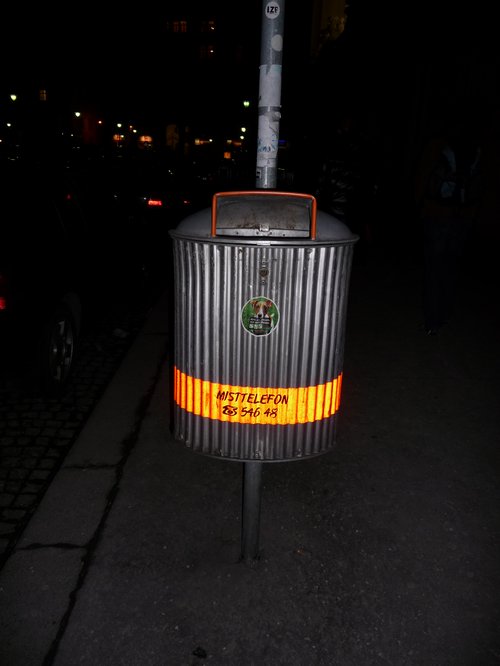
Still need to figure out why they’ve put this number on all waste bins.
Interesting to compare German German with Austrian German.

I will actually go for almost any beer, but – just for the records – they also have Guiness.

Now this is very impressive. Even have a panorama shot of this somewhere (I still need to go through all of my snapshots and upload them on flickr).
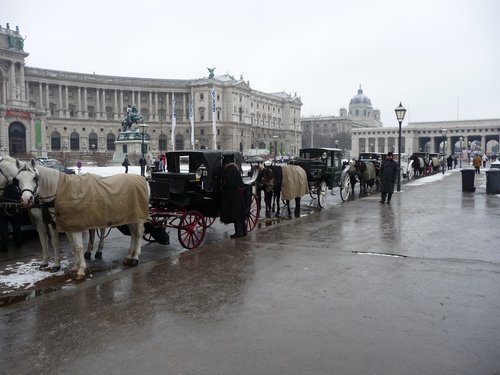
The obligatory service for tourists. But a nice one indeed!

Compared to buildings from the past, modern architecture is as uninteresting as most modern cars that will break down after 100.000 kms.
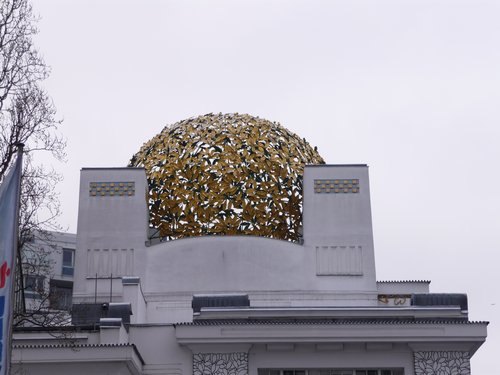

Modern art + her.
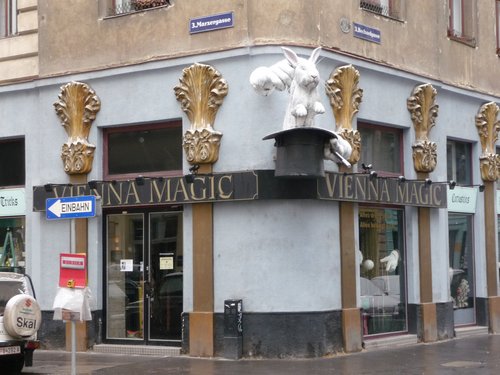
Vienna Magic

The globe
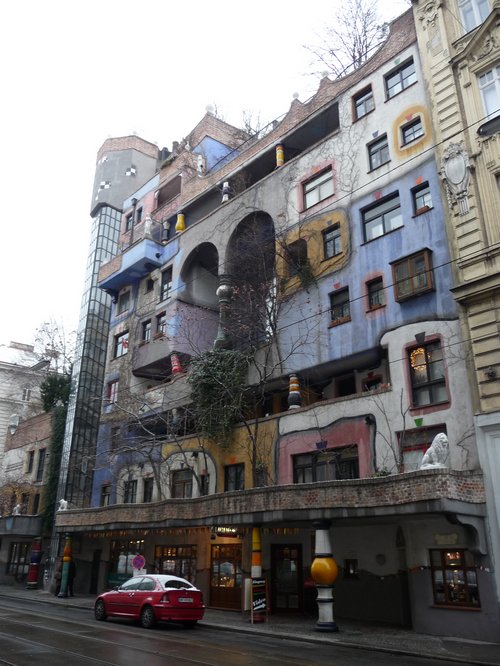
One of those Friedensreich Hundertwasser buildings.
I grew up on his art – maybe everyone in Europe who is somehow interested in art did – and I really, really like it. Hundertwasser also published a manifest on dry toilets in 1975 which is just another cool reason to adore this great visionary artist and intellectual.
You won’t have to visit Vienna to see his work, but since he was born in Vienna, they have the best collection around.
I’d even go as far as saying that Hundertwasser is one of the few visionaries that put my vision of a better world in a clearer picture.
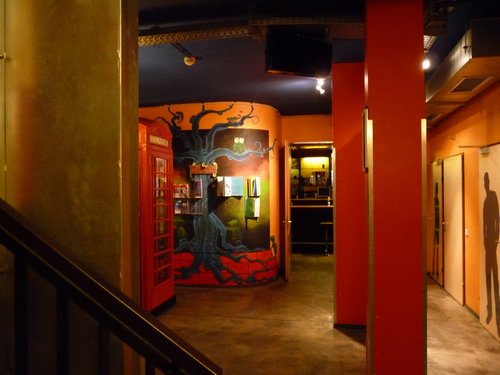
Foyer @ Wombat’s Base – a great, clean and cheap city hostel. I’d recommend this to anyone who’s still looking for good accomodation in Vienna.

“We’re sinking, we’re sinking….” – “Wot are you thinking about?”
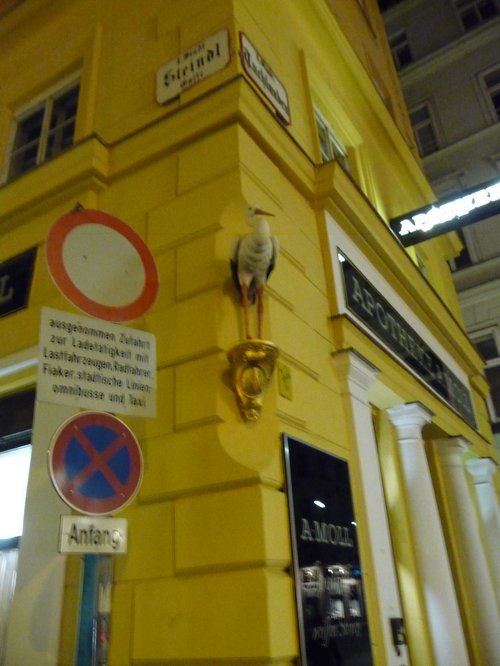
Errr….well….
Ok – that’s about it for today. These 2 1/2 days weren’t enough and you can see by the pictures that we even didn’t have enough time to enjoy everything during daylight (due to AfrikaCamp, see previous post). Train ride from Frankfurt to Vienna is quite convenient though. Took us 7h – even the above mentioned hostel is next to the railway station. What a luxury!
I’d spent the first eight years of my life growing up in Tokyo, Japan, and since we’ve never been back to Japan since then, I was very pleased today to discover that the house we’d lived in still exists:
I may not be such a great fan of Google services (even though I have their ads on my blog), but this Google Street view feature just rocks big time. It’s also interesting to see how the city has changed over the last 30 years – at least by judging from what’s visible through Goolge Maps.
From a professional point of view, of course, I am nowadays wondering about the sewage system in use in Tokyo, and how they manage to provide all this high-tech infrastructure in such a densely populated area.
New year’s resolutions are supposed to be made – and then quickly forgotten.
I can’t even remember if it was a new year’s resolution, but it’s January 2009 now and the wife (“she”) said we’d have to go on a diet. South-Beach Diet.
If you’re married or at least engaged, you’ll know that wise men never oppose a female decision (but instead wait for them to remorse on their own). This especially applies to those poor fellows who are married to Thatcheresque characters.
The painful truth is that she’s right. We both urgently need to lose weight – not because we’d been surviving on junk food only (she’s vegetarian anyways), but because food in Germany is just more than nutritious. Whenever I am in Kenya, I lose weight. But here in Germany, it’s just massive. And then all these sweets!
Sweets, dear readers, are one of the two fine reasons why I like German food (the other is Bavarian Leberkäse). And not only packaged Haribo winegums and liquorice, but also fresh cakes from a bakery:

Choice 2.0
Now compare that with the usual “variety” of marble cakes as found in the average Kenyan supermarket. What a difference and sweet temptation!
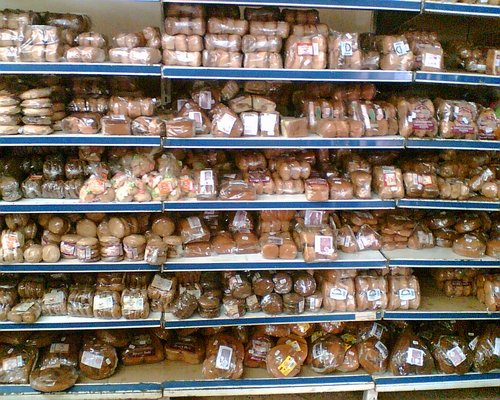
Choice 1.0
Ati? Do I hear you longing for the typical BlueBand (instead of butter) “butter” cream cake?
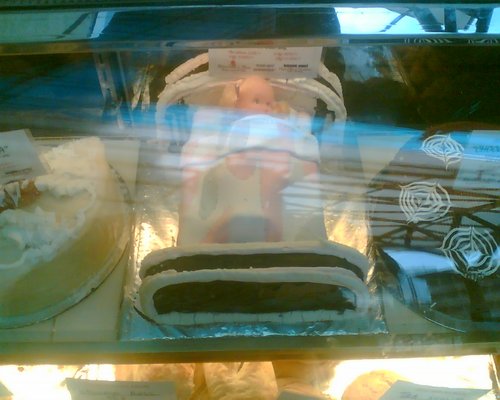
The strange Barbie cake found in Nbo the other day
See? That’s the dilemma now. Living in a country where the sweets section alone can fill up a whole supermarket and even provides a bigger variety than the usual and rather boring marble & butter cream cakes as found in ex British colonies (sorry, but I blame this heritage purely on the British inability & disinterest in cooking & baking), you’ll quickly end up eating too many sweets. Just because they are readymade food and can be eaten quickly. And of course because I love sweets.
Other members of the extended family already tested this diet – or let’s say: change of diet, and it worked quite well for them. You’re basically not allowed to eat any bad carbohydrates during the first two weeks, which obviously also includes sugar, bread, potatoes and so on. The list of the NO-GOs is actually quite long – the one of those things you’re allowed to eat rather short.
As you may know or not know: Germans love to have a sweet breakfast (e.g. bread with jam), so this diet requires her to switch to scrambled eggs and bacon instead (ok, this is what I like about UK kitchen at least).
As for lunch and dinner, we’ve so far prepared vegetable dishes based on chickpeas, eggplant, garlic and sometimes even meat (for me, not for her). The meat part actually is quite nice because I didn’t have a proper steak until Xmas and until my good old ex-vegetarian sister Zora recently informed me she’d switched to being a carnivore. @Zora – in case you’re reading this: see how your actions influence my life! :-)

A snapshot I’d already twitpic’d: looks like Githeri to me, bila potatoes and beans. That’s dal fry, actually. Lentils + onions + tomatoes + some chick peas + curry. Delicious!
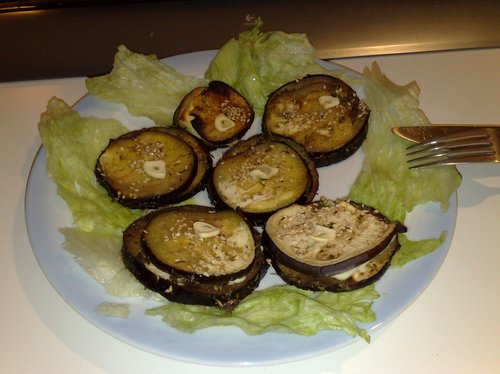
Eggplant/Aubergine with Turkish cheese and garlic + sesame. Grilled in the oven. This really is a perfect dish anyone can prepare within a few minutes.

Some kind of steak I’d cut into pieces because I wasn’t sure about its age (@intelligensia see “Rost and mboilo”, p.46 , “How to be a Kenyan”). Next time I will just choma this kabisa in the grill. Love the fresh broccoli though, very al dente (mushy food is a no-go except for Irio). I shall have even more meat during the coming weeks. Yay!
—–
Other, food related matters that are worth mentioning and actually require their own post is Vegefarm – a vegan/vegetarian restaurant opened by very good friends of mine in Bremen – a city in Northern Germany.
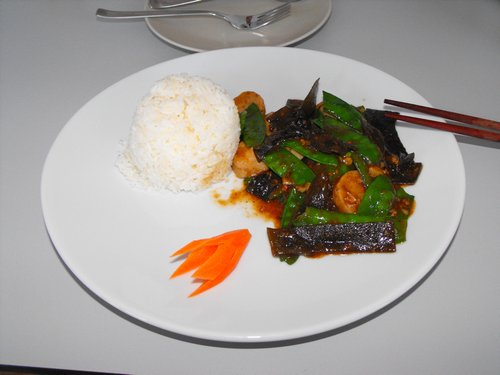
What they do is serving special dishes that almost taste like real meat or fish, but are purely based on gluten, tofu and shitake mushrooms and probably also other vegan ingredients. Quite SE Asian – they used to have a Chinese restaurant (already serving vegan dishes back then) but have since switched to this cuisine only. And best of all is that you can order these fake meat and fish balls based on Tofu & Co. online. I’d seen them importing these directly from Taiwan some years ago, so it’s extremely nice to see them coming up with a full restaurant these days that only serves such dishes.
Those dark green “leaves” on the image above are algae from the sea – and since I grew up on Japanese food, I really, really love the taste of this green seaweed.
—–
Yes – that’s about it so far. From seaweed to ugali na sukuma to sweets. And there you go wondering why I’d gained weight.
Interestingly though, and the intial reason for blogging all of this: it seems that if you want to survive on staple food only (starch), you’ll pay much less. Try to find decent (!) vegetable during winter season in Europe and you’ll quickly realize that the only place where vegetaboools taste like having grown under the sun (and not in some artificial greenhouse in Spain) is among Turkish supermarkets, next to those Afroshops downtown.
Of course, once I’m done and have lost my targeted 10kgs (hey..easy!), I will have to start my Leberkaese business idea in Kenya :-) Serving tasty meat snacks to commuters – how’s that for a change?
p.s.: I consider this post part of my lifelong Bantu-food-bashing-meme which aims at spreading Swahili food culture from the Kenyan coast to all parts of Central Kenya. Eh!
Following my first prototype for an improved X17 organiser and a stolen parcel that was later on found soaked in the shrubbery next door…
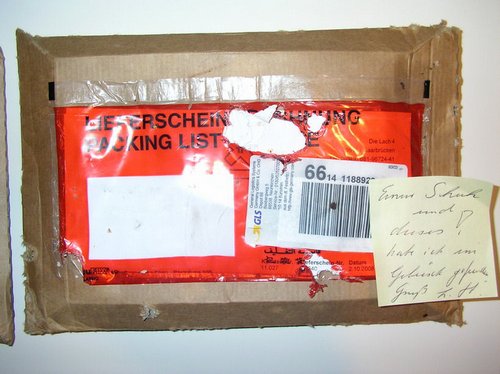
…I eventually managed to modify the ordered Texon-based X17 timer according to my needs.
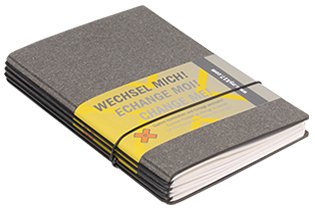
As you may remember from my first post on this, X17 is a small company based in Saarbrücken, close to the French border, that also produces the X47 system – an advanced organizer system based on a spring-load mechanism that substitutes the “six-ring loose-leaf binder system” as seen on all other traditional filofax system. Filofax are nice, but! they waste a lot of space – as opposed to these X17 planers that on one hand offer the full space of a normal A5 (A6, A7) note book, and on the other hand are still exchangable. Obviously, it was time to send my filofax into early retirement and put my hands on a better system. I am not saying that X17 is the best system out there, but the best alternative I’ve come across so far and one which is also affordable: the timer itself costs 14,95 EUR in it’s cheapest version (hard paper oder Texon cover).
While waiting for the parcel to arrive, I had already made some plans on how to modify the system, e.g. include side pockets for important stuff and also add a few coloured strings that I can use as bookmarks. Simple modifications that just add user value to this already smart system which is btw based on elastic rubber as the binder mechanism.
So this is what I did with my new Texon-based X17 timer:
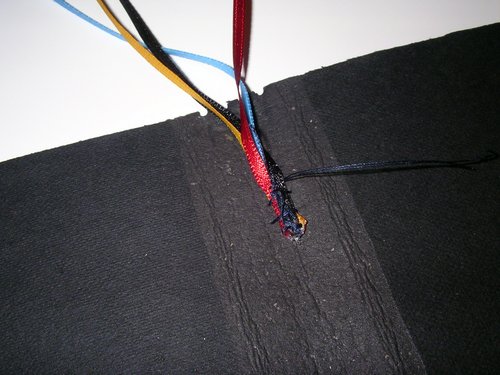
I first sawed the bookmark strings to the back….
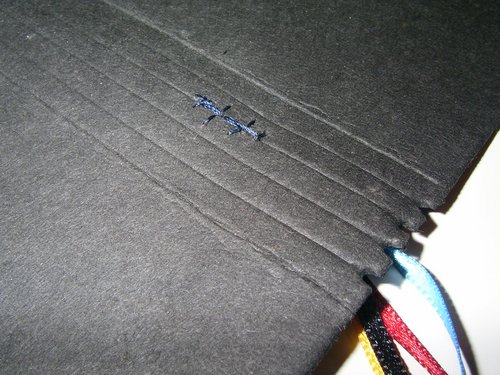
…where you can already spot the distinctive “half holes” at the side which provide stability & guidance to the rubbbers…
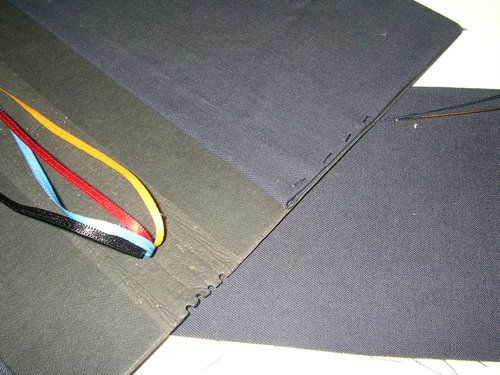
…and fixed simple side sleves inside.
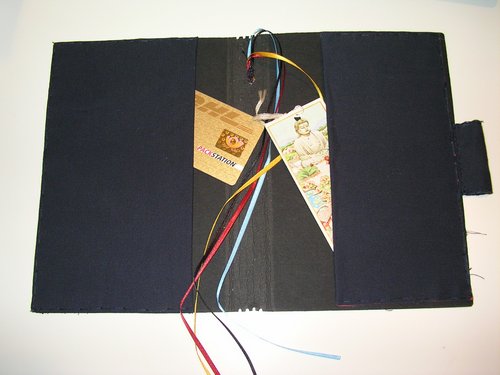
Please also note the pen holder at the right side which is very important to me. I prefer fountain pens btw, and the paper calendar inside is strong enough (80g/m²) to withstand the ink (an important detail!).
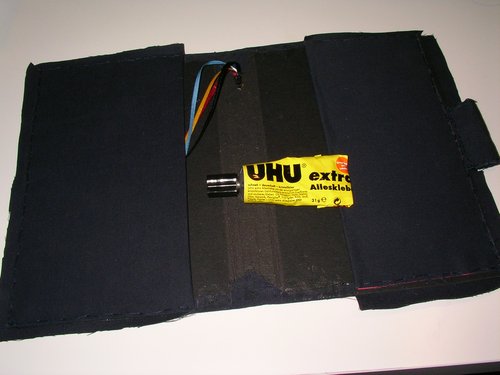
Next task was to add the back cover, whereby I had make sure that I just glue it to the back (outside) cover and don’t use any visible seams.
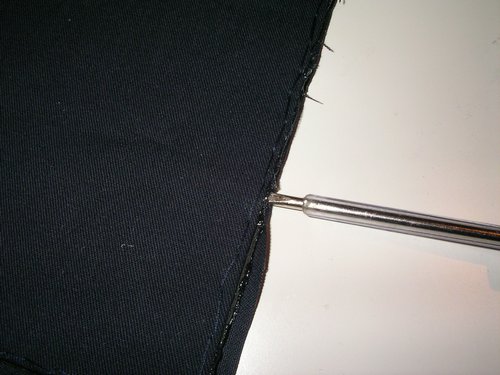
I used a screwdriver to squeeze the remaining cover behind the side pockets inside.
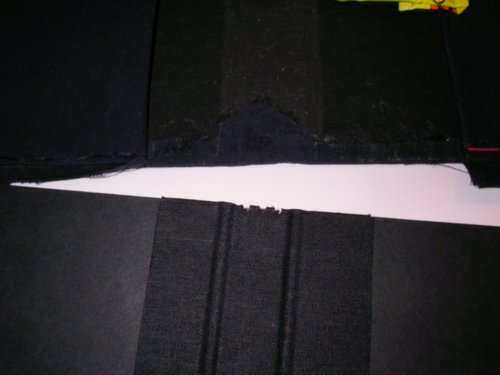
Now, as you can probably see from this direct comparison between these two X17 timers, the half holes were missing on the modified Texon-based version, but it still works because these rubbers have enough tension to find their own way into the material.
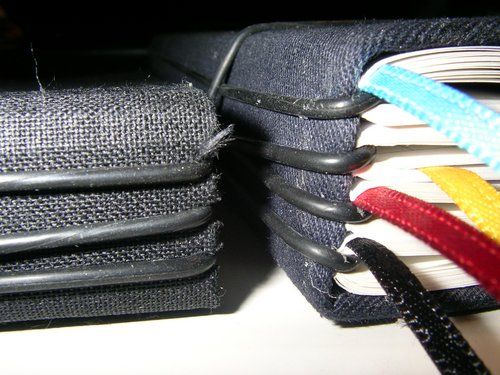
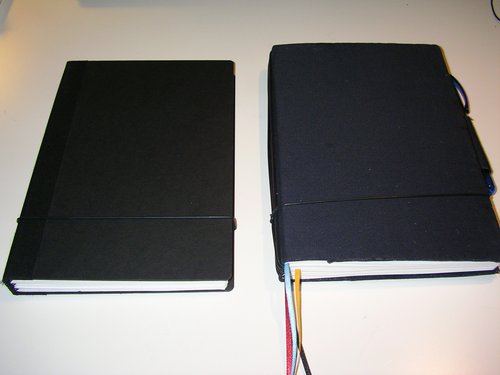
This is btw also the very reason why I went for the Texon (= soft material, right) version instead of the hard papered version as pictured above (left): the cardboard version only provides three holes, thus only three “rails” for rubbers, whereas the soft Texon version offers 4 holes. Unfortunately, this isn’t indicated on their website (yet – I guess I am the only freaky customer who further modifies his purchases and then blogs on them like a little kid :-).
I’ve btw given the cardboard version to my wife who already loves this system (she also only had a filofax before..).


Now, can you see the difference between the conventional filofax system and my modified X17 timer? I’d say it just rocks!
More space also means you’ll have extra room for weekly notes – which is very important for a proper management and substitues the many post-it notes that used to fly around.
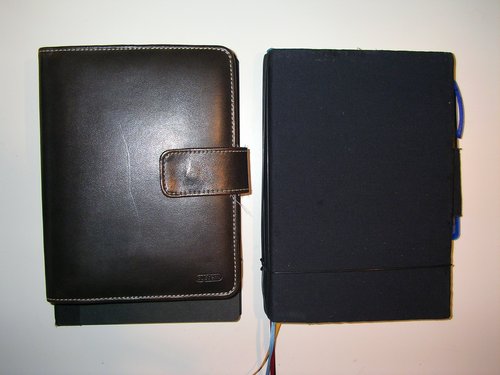
all three versions directly compared: cardboard X17 for three A5 booklets (left, below), old filofax system on the left and my modified X17 organiser containing four A5 inlays.
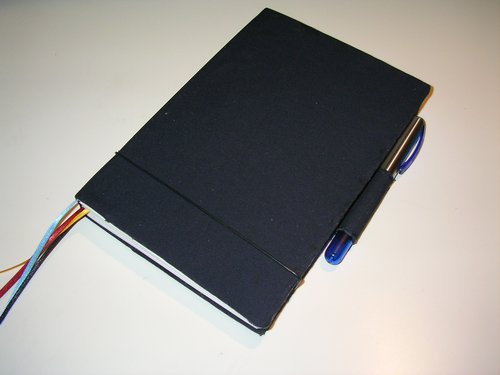
Et voilà , my very own new timer that provides enough room for notes, keeps them ALL in ONE place, has bookmarks, two side pockets that contain extra stuff and a pen holder for my fountain pen.
This is the system I always wanted to have.
Verdict: If you’re not that happy with you existing Filofax system, X17 provides an interesting and affordable alternative. If you want to spend more money, you can just as well go for the X47 alternative (which is really sexy and has a beautiful finish).
I would also like to recommend the RoterFaden system, which in my mind is a bit more jua kali and maybe more practical for those who usually keep a mixture of notes inside their timer. I prefer the X17, though.
It would be interesting to know if there are any other, papered organisers out there that provide similar comfort. If you know of any, pls feel free to drop a comment here. Thx!
P.S.: It would also be interesting to know if a franchise/spin-off for the X17 could be arranged with African makers, e.g. X17 covers produced in Kenya with natural materials that could be certified with a Cradle to Cradle certification and then equipped with these high quality inlays from Germany. Ah, I guess it’s a matter of import taxes and maintaining quality standards among others, but still – the money is on the paper content, not the covers which are only purchased once. Or? (Eurogadget vs. Afrigadget?).
Working as an external consultant, I really needed to reorganize my personal organiser and put it in a much more effective combination.
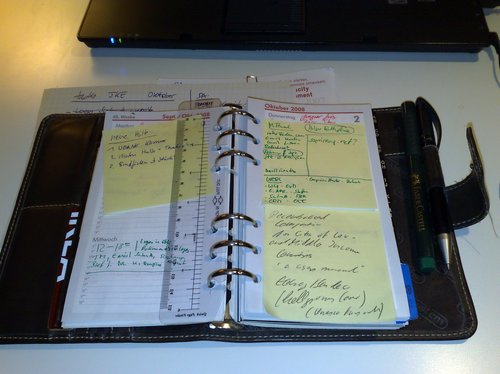
my old personal organiser
Imagine I’ve been using this traditional filofax (“file of facts”) system for the last 10 years and often didn’t have enough space to keep my notes. Plus, I am one of those folks who write down every little idea and try to keep the rest in my head.
Computers? PDAs? Mobile Phones? Well…as long as there’s no perfect solution that will synchronise any mobile phone with any adress book & notes and any corporate-restricted MS-Exchange Server and other services (= no common standard, sigh), I’ll keep on using paper – and besides: it’s faster and will never run out of batteries.
Having said that, what I am actually looking for is a system that a) provides enough room for my extra notes (e.g. a clamp somewhere where I can just attach them) and b) provides the maximum space without keeping me from writing on the left page because of a stupid six-ring loose-leaf binder system as seen on my old filofax above.
Proper time management certainly does not only depend on the perfect personal organiser, but for me, it starts with it.
And fancy Moleskine notebooks?
No. They just don’t do it for me even though they are quiet sexy, slim and have enough followers who love them. Moleskine notebooks are a 1-year solution to me. And yes, I know that some ppl just like it that way and keep their Moleskin archives on their shelves or hidden in drawers.
As far as I am informed, there are currently three different products available on the German market that offer a solution to my problem:
1. Fellow blogger Christian already recommended a very nice product from Germany which is sold under the brand name “Roter Faden” (~ red line) and which uses aluminium clamps on both sides to fix up to three special books inside:
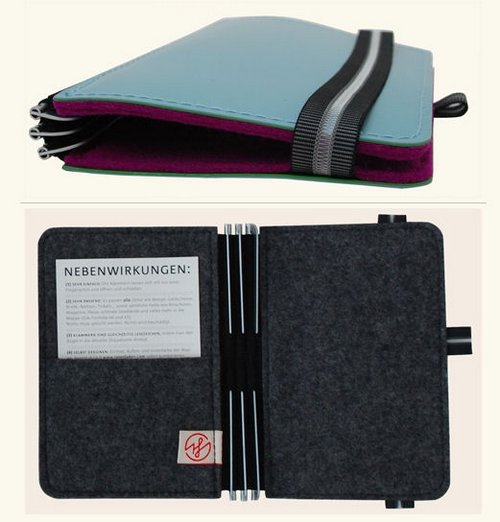
Their website is unfortunately only available in German and with around 50,- EUR for an empty planer (special booklets containing a weekly calendar, address book & empty paper is sold seperately), it’s one of those solutions you’ll only go for once you’re sure it works for you.
There are only two official dealers for this system in Frankfurt and I am yet to see it in live action. I already like the mechanism that allows a quick removal of the content and – the biggest and most important advantage over to the traditional filofax solution: you can actually use all space as there’s no stupid ring binder in the middle. Sweet!
Another advantage is that you have an extra pouch for important papers, although rather rudimentary. Any disadvantages? Well…the more you stick inside it, the bigger it grows. Do I want my organiser to look like Dan Eldon’s sketchbooks? Well…. :-)
2. Then there’s the X47 system developed by another German who initially built his first prototype way back in the 1980s as a student and some years later on recycled his idea and improved it.
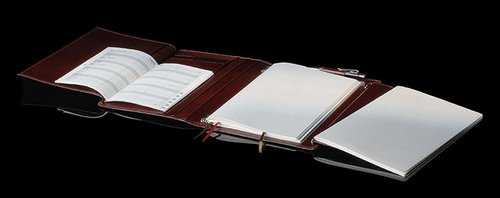
If I had enough money, I’d probably go for one of the X47 solutions as they are the most beautiful planers I’ve ever seen.
This so-called book-by-book system also uses a special spring mechanism (“spring loaded spine rail”) that holds these extra booklets in place and replaces the usual ring mechanism. While there are different sizes available (even some inside a wallet!), I’ve figured that I should switch to an A5 format which provides enough room for my extra notes that I still want to clip into this planer. Contrary to conventional filofax systems or even the RoterFaden solution above, these timers will not grow in size. Nice! The name X47 actually comes from the fact that the missing ring mechanism provides 47% more paper space.
If you’re seriously interested in getting a perfect GTD-solution, this could be your personal organiser (albeit prices are somewhere between 100,- – 300,- EUR!).
3. The same guy who invented the X47 system knew that his system is a bit too expensive for the average customer (heck, I could even get a Netbook for that price!), so he tried to look for another, cheaper solution based on…. rubbers!
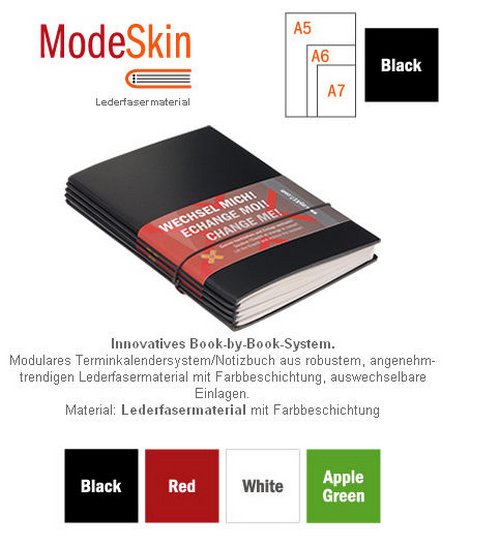
Instead of an expensive spring loaded mechanism, these rather simple organisers are held together by a set of rubbers. The inventor actually patented the system and got a patent on “a half hole” – which are required at the side of the organisers to keep everything in place. Check out their website for more info on this simple setup. Obviously, this is one sweet Eurogadget :-) solution I’ll like!
So I bought it.
I actually just bought the papers inside and these special rubbers (which are normally used as gaskets in the automobile sector, so they are quite durable) because they didn’t have the cheap cover edition I was actually longing for and because I had already made up plans on how to modify this solution according to my needs. Since there doesn’t seem to be *the* perfect solution, I’ll have to create my own.
Welcome to my first prototype!
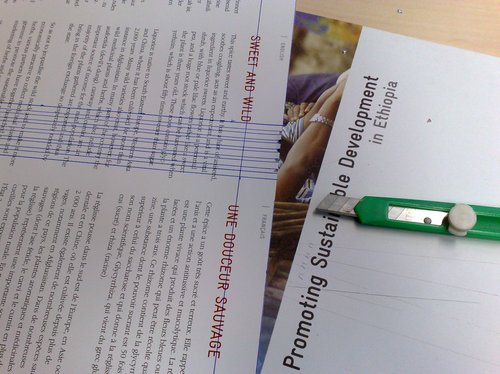
use some stronger paper from a calendar and cut out the desired size
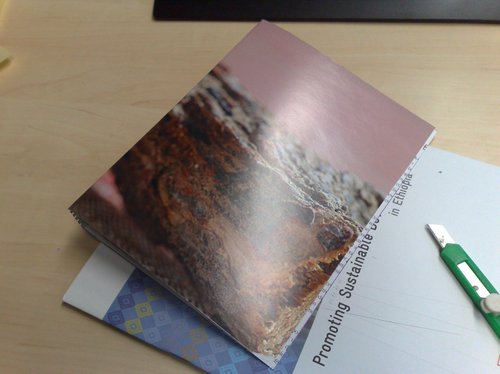
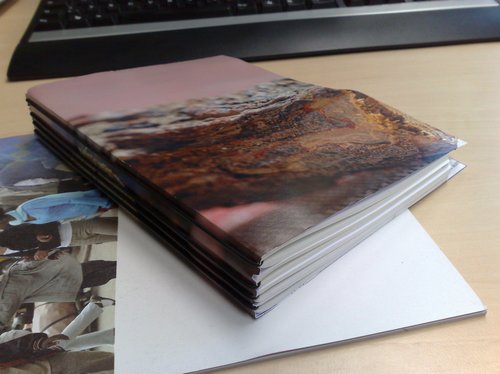
(in case you’re wondering: that’s an image of natural Liquorice on the cover – as mentioned, I’d taken a page from an office calendar :-)
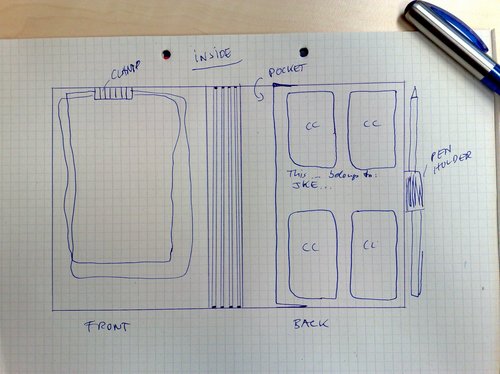
Yeah ok, this is what I want it to feature. Left: a clip for extra notes in A5 format, in the middle the four booklets (empty notes, address book, calendar 2009, 1st & 2nd part), and to the right: a small pouch for loose content and some business/credit/customer cards + a pen holder.
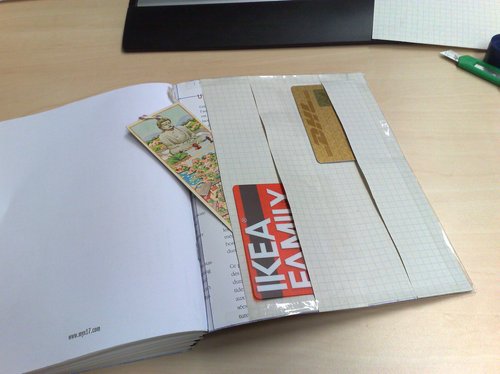
last page on the papered prototype (./. pen holder)

And look, even a CD fits in there!
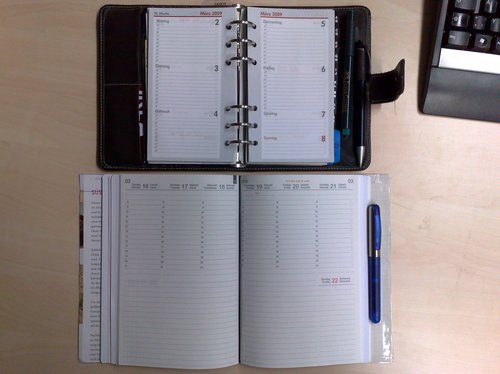
old vs. new
I’ve actually ordered a cover from X17 (which is yet to arrive) because my next step is to modify it according to the papered prototype above and add these little extras using the fabric I normally use (green canvas material from Kenya + some leftover parts from my grandmothers ball gown – aii, sijui about the latter one…).
Is there any other system you can recommend that fits into this scheme? Comments, please!
Thengiu muno.
[UPDATE] In part two of this post, I talk about the modifications I did to my X17 timer.